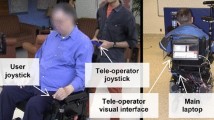Abstract
This paper describes a semi-autonomous wheelchair enabled with “HelpStar” that provides a user who is visually impaired with mobility independence. Our “HelpStar” enabled semi-autonomous wheelchair functions more like a personal assistant, allowing much greater user independence. When the user finds themself in an unforeseen circumstance, the “HelpStar” feature can be activated to allow a remote operator to use Virtual Reality technologies to provide helpful navigational instructions or to send commands directly to the wheelchair. This paper demonstrates the successful integration of assistive technologies that allow a person who is visually impaired and using a wheelchair to navigate through everyday environments.
Access this chapter
Tax calculation will be finalised at checkout
Purchases are for personal use only
Preview
Unable to display preview. Download preview PDF.
Similar content being viewed by others
References
Adelola, I.A., Cox, S.L., Rahman, A.: Adaptive Virtual Interface for Powered Wheelchair Training for Disabled Children. In: Proc. of 4th Intl. Conference of Disability, Virtual Reality & Assoc. Technology, Veszprém, Hungary, pp. 173–180 (2002)
Arkin, R.C.: Behavior-based robotics. MIT Press, Cambridge (1998)
Brooks, R.A.: How to Build Complete Creatures Rather than Isolated Cognitive Simulators. In: VanLehn, K. (ed.) Architectures for Intelligence, pp. 225–239. Lawrence Erlbaum Associates, Hillsdale (1991a)
Brooks, R.A.: Integrated Systems Based on Behaviors. SIGART Bulletin 2 2(4), 46–50 (1991b)
Evolution Robotics, Evolution Robotics ER1 Robot Kit (2004), from http://www.evolution.com/education/er1/ (retrieved October 12, 2004)
Gomi, T., Griffith, A.: Developing intelligent wheelchairs for the handicapped. In: Mittal, V.O., Yanco, H.A., Aronis, J., Simpson, R.C. (eds.) Assistive Technology and Artificial Intelligence. LNCS (LNAI), vol. 1458, pp. 150–178. Springer, Heidelberg (1998)
Gundersen, R.T., Smith, S.J., Abbott, B.A.: Applications of Virtual Reality Technology to Wheelchair Remote Steering System. In: Proc. of 1st Euro Conf of Disability, Virtual Reality & Assoc. Technology, Maidenhead, UK, pp. 47–56 (1996)
Inman, D.P., Loge, K.: Teaching Motorized Wheelchair Operation in Virtual Reality. In: Proceedings of the 1995 CSUN Virtual Reality Conference, California State University, Northridge (1995), from http://www.csun.edu/cod/conf/1995/proceedings/1001.htm (retrieved October 1, 2004)
Lankenau, A., Röfer, T., Krieg-Brückner, B.: Self-localization in large-scale environments for the bremen autonomous wheelchair. In: Freksa, et al. (eds.) Spatial Cognition III. LNCS (LNAI), vol. 2685, pp. 34–61. Springer, Heidelberg (2003)
Levine, S.P., et al.: The NavChair Assistive Wheelchair Navigation System. IEEE Transactions on Rehabilitation Engineering 7(4), 443–451 (1999)
Matarić, M.J.: Behavioral Synergy without Explicit Integration. SIGART Bulletin 2 2(4), 130–133 (1991)
Matarić, M.J.: Behavior-Based Control: Main Properties and Implications. In: Proc. of IEEE Int.l Conf. on Robotics and Automation, Workshop on Architectures for Intelligent Control Systems, Nice, France, May, pp. 46–54 (1992)
Miller, D.: Assistive robotics: an overview. In: Mittal, et al. (eds.) Assistive Technology and Artificial Intelligence. LNCS (LNAI), vol. 1458, pp. 126–136. Springer, Heidelberg (1998)
Polhemus Inc., LIBERTYTM (2004), http://www.polhemus.com/LIBERTYTM.htm (retrieved October 12, 2004)
Rao, R.S., et al.: Human Robot Interaction: Application to Smart Wheelchairs. In: Proc. of IEEE International Conference on Robotics & Automation, Washington, DC, May 2002, pp. 3583–3588 (2002)
Uchiyama, H.: Behavior-Based Perceptual Navigational Systems for Powered Wheelchair Operations, Master Thesis Proposal at the University of Georgia (2003), from http://www.cs.uga.edu/potter/robotics/HajimeThesisProposal.pdf (retrieved October 11, 2004)
Yanco, H.A.: Integrating robotic research: a survey of robotic wheelchair development. In: AAAI Spring Symposium on Integrating Robotic Research, Stanford, California (1998)
Author information
Authors and Affiliations
Editor information
Editors and Affiliations
Rights and permissions
Copyright information
© 2005 Springer-Verlag Berlin Heidelberg
About this paper
Cite this paper
Uchiyama, H. et al. (2005). A Semi-autonomous Wheelchair with HelpStar. In: Ali, M., Esposito, F. (eds) Innovations in Applied Artificial Intelligence. IEA/AIE 2005. Lecture Notes in Computer Science(), vol 3533. Springer, Berlin, Heidelberg. https://doi.org/10.1007/11504894_111
Download citation
DOI: https://doi.org/10.1007/11504894_111
Publisher Name: Springer, Berlin, Heidelberg
Print ISBN: 978-3-540-26551-1
Online ISBN: 978-3-540-31893-4
eBook Packages: Computer ScienceComputer Science (R0)




